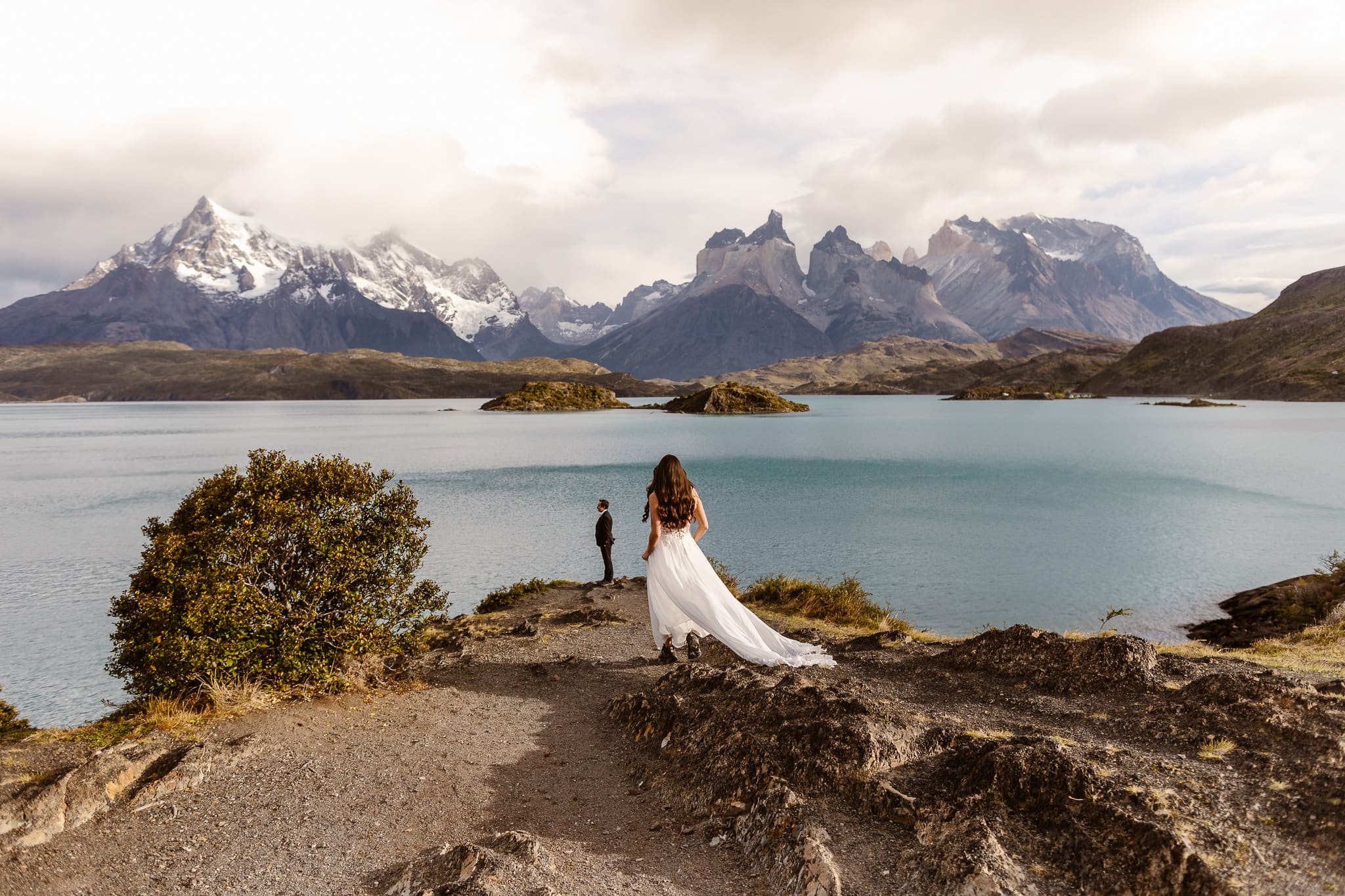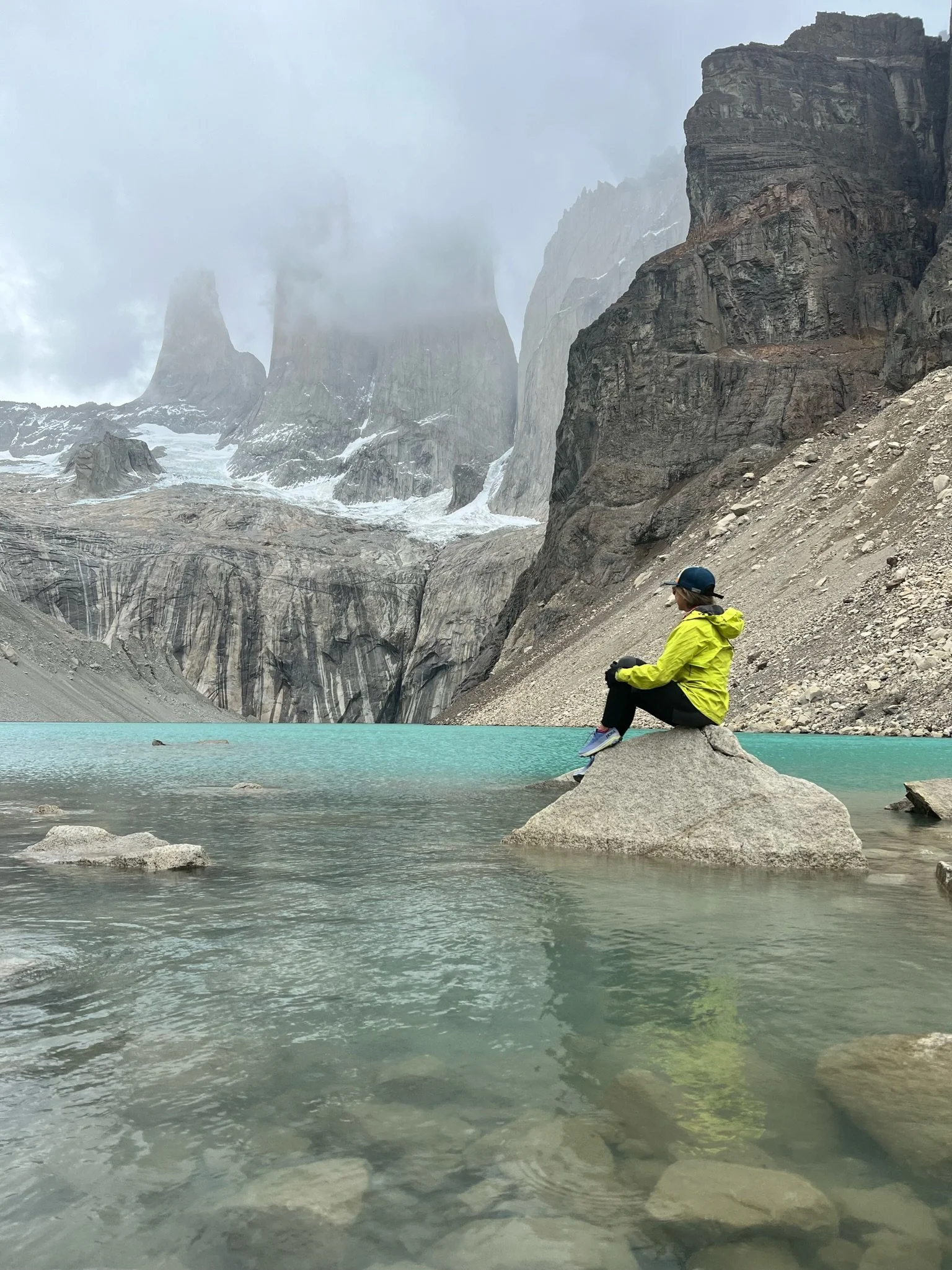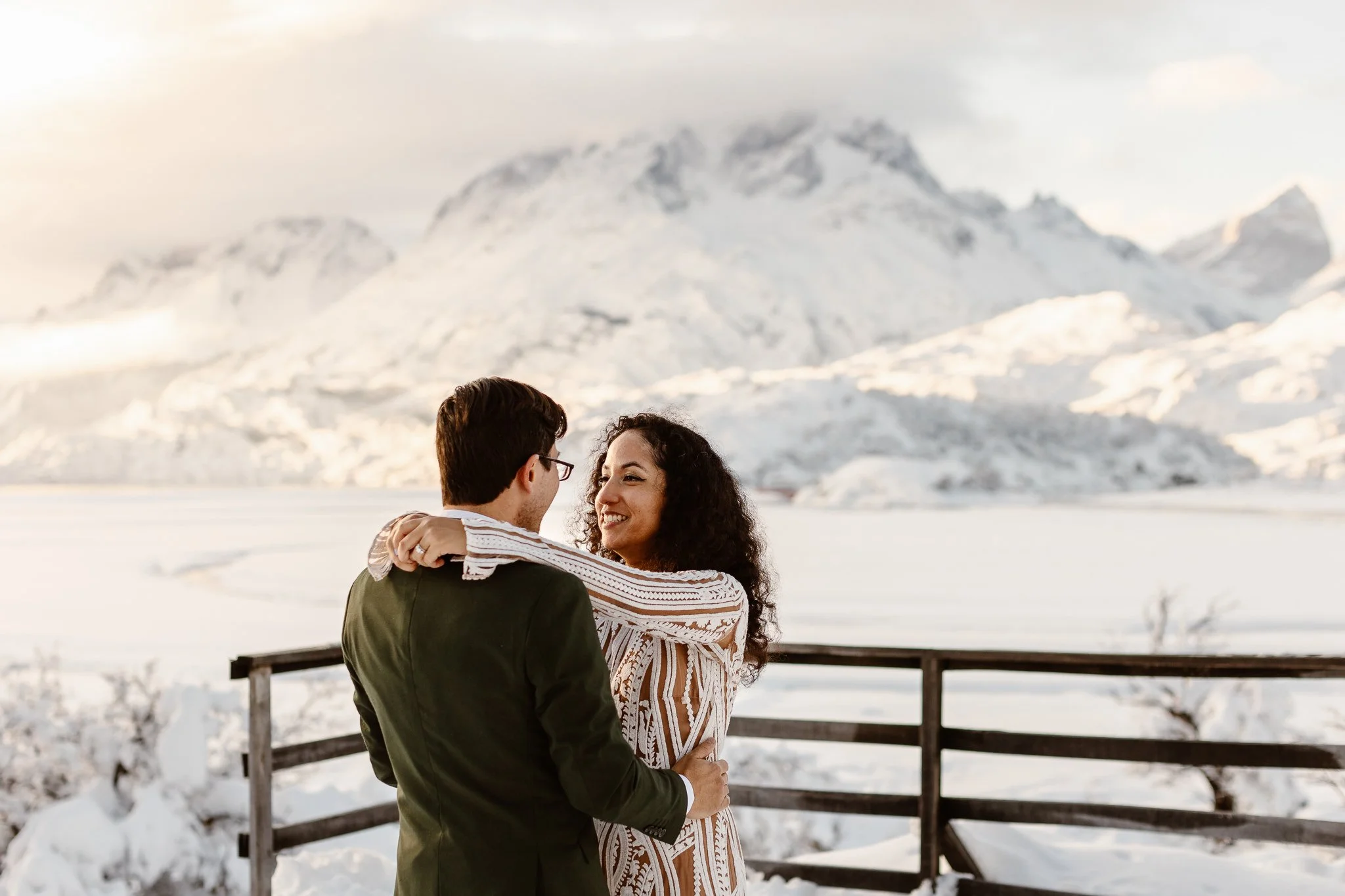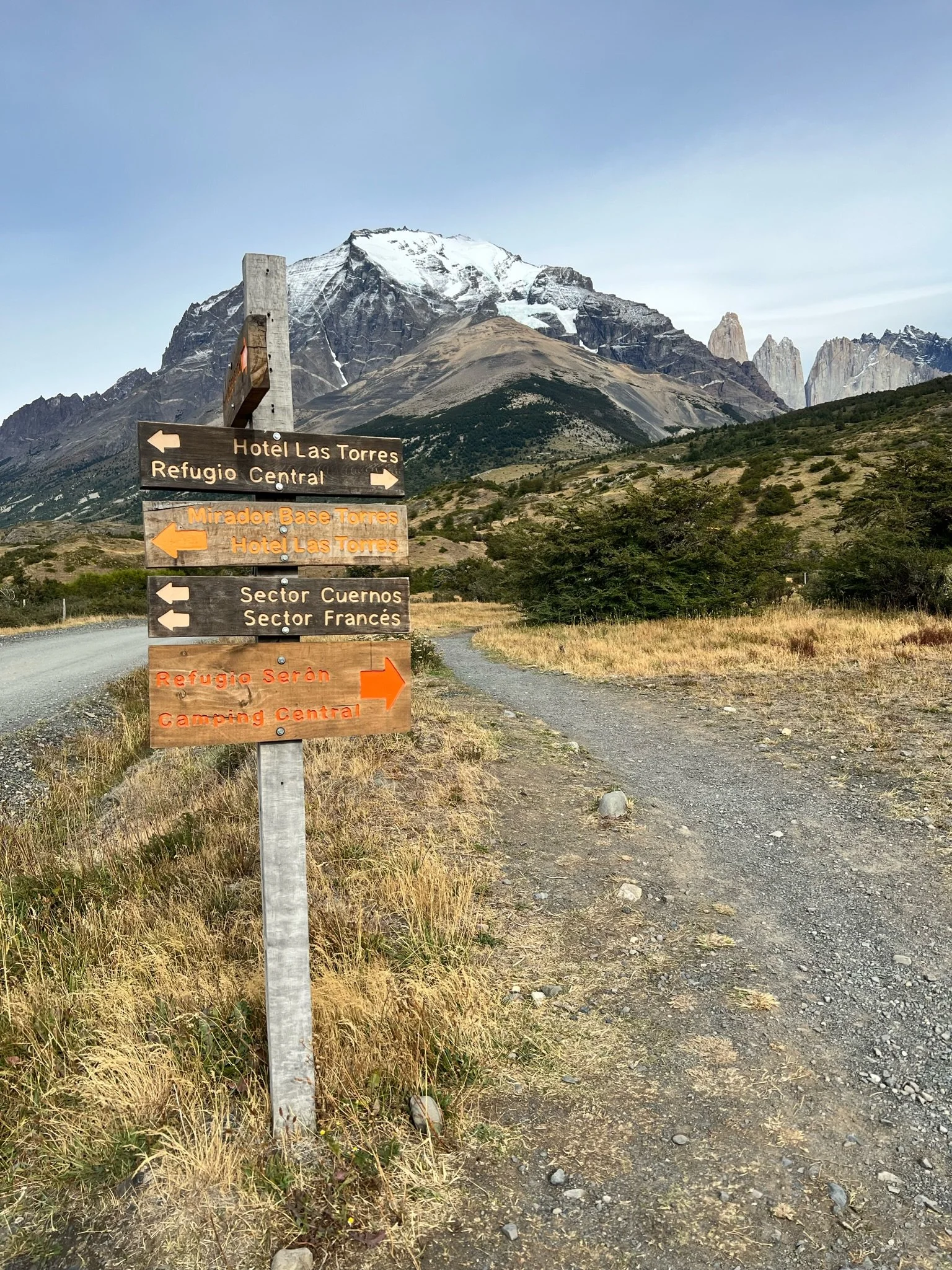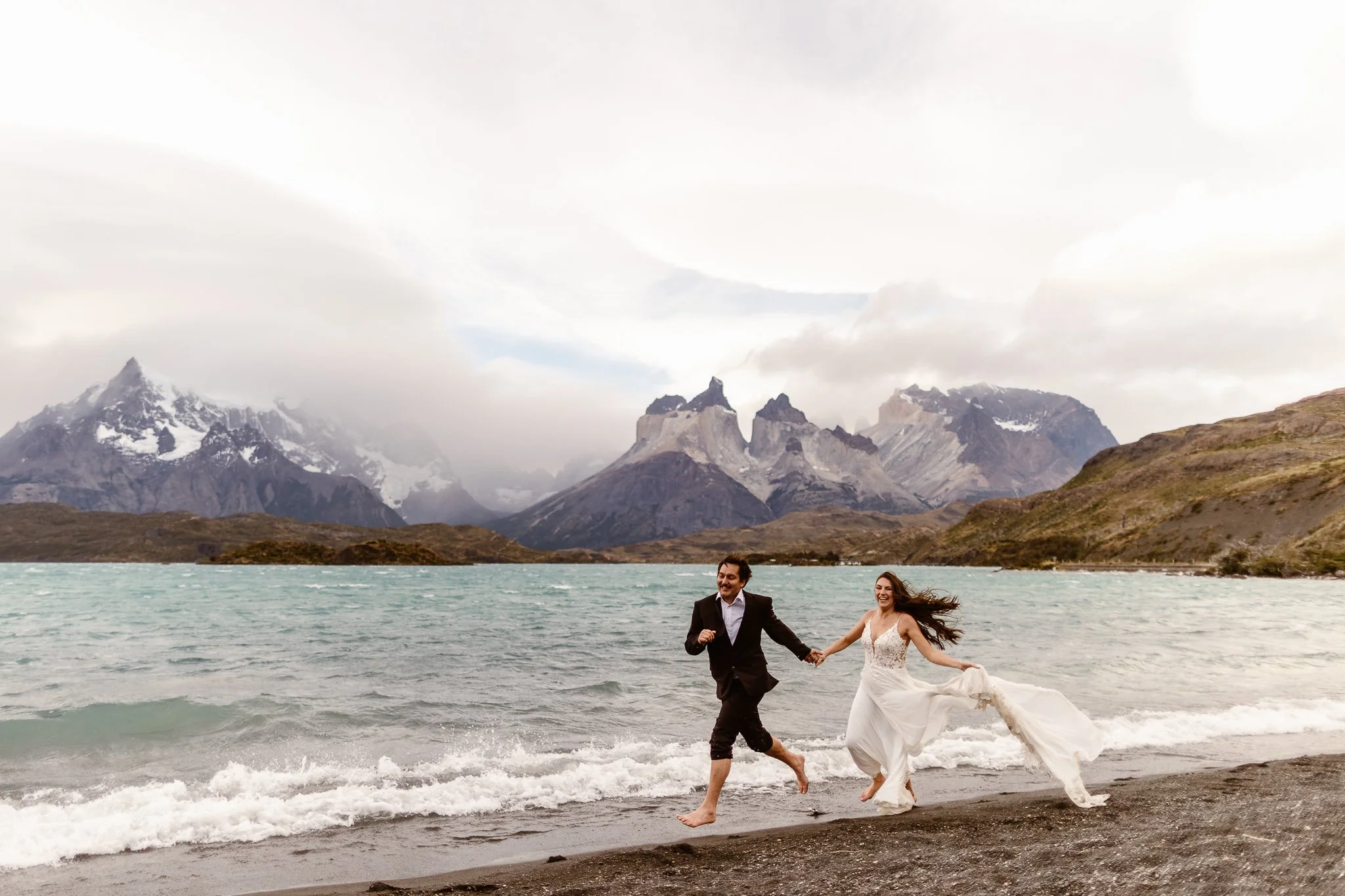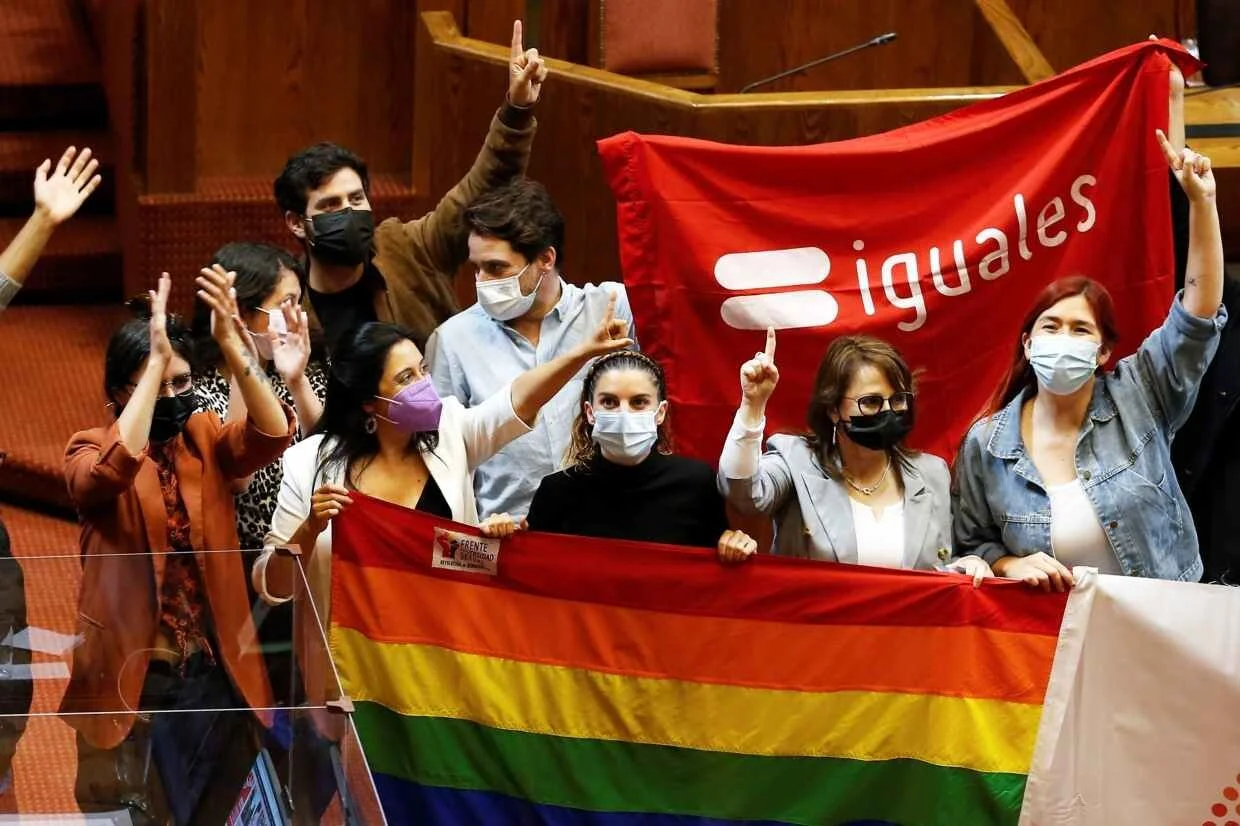How to Elope in Patagonia: An Expert’s Guide to Everything You Need to Know | Updated for 2026
Updated November 7th, 2025
Updated for the 2026-2027 Wedding Season
A Patagonia Elopement Photographer’s Guide to Everything You Need to Know
M + L’s summer elopement (late February) in Torres del Paine, Patagonia
Table of Contents
Quick note: As an affiliate member for REI, VRBO, and Amazon, this post may contain links to recommended products or services that I use myself and love. If you make a purchase after clicking one of these links, I earn a small commission (at no extra charge to you). I promise any latte money earned ☕️ will be used to create even more useful content like this! Thank you!
J + M’s fall elopement (mid-March) in Torres del Paine, Patagonia
You met by chance, fell madly in love, and eventually said yes to the perfect proposal. Now engaged and ready to start your life together, you’ve decided to do things differently by skipping the traditional wedding and choosing something that feels more you.
Suddenly, eloping is starting to sound exciting! Envision the privacy, the calm, the adventure, and the freedom to create a day that’s truly your own. Then comes the question: Where? And the answer becomes clear: somewhere breathtaking, somewhere unforgettable - Patagonia!
At the southern tip of South America, where Chile meets Argentina, Patagonia is one of the most remote and striking places on Earth. Towering mountains, massive glaciers, vast open plains, and clear blue lakes stretch for miles.
The weather can change in an instant, the wind is constant, and the landscape feels endless. It’s the kind of place that reminds you how big and beautiful the world really is.
There’s no better backdrop for a wedding that’s all about connection, intention, and adventure. Picture it: the two of you surrounded by the wild, unexpected beauty of Patagonia while saying yes to forever at the end of the world!
M + L’s summer elopement (late February) in Torres del Paine, Patagonia
Why You Need an Expert
You may well imagine– due to its seclusion, its magnitude, its varied landscape, and its sometimes volatile weather– Patagonia is an elopement destination for which you will absolutely need a trusted, confident expert to guide you. That’s me!
Photographer Andrea Enger enjoying a misty view of the Torres (“the towers”) in Torres del Paine national park.
As a native of Chile, Patagonia is a part of who I am. I spent over twenty years there– backpacking, adventuring, exploring– before marrying and relocating to the United States (sunny Colorado) a little over ten years ago. Since moving, I have been back to Patagonia six times, staying (cumulatively) over 18 weeks there. In that time, I hiked over 630 miles in Patagonia’s extensive terrain, and I have photographed multiple elopements. I know the place– and its people, its customs, its language, its culture– deeply and intimately.
You need a photographer who is well-versed in all the fine details and intricacies of an elopement of this type. Someone who knows the land well and can safely navigate its vast terrain. Someone who knows all the perfect places and can help you choose which spot is right for you. Someone who can connect you with the right vendors, guide you to the best hotels, set you up with a planner and videographer (if you so desire). Someone who understands the park systems and even knows its rangers.
I have first-hand, in-depth knowledge of Patagonia and, as such, you can trust me to shepherd you through each step of the elopement process– from inception to conclusion. Much more than just your photographer, I will help you curate and execute precisely the wedding of your dreams!
Where to Elope in Patagonia
As previously noted, Patagonia is a massive region– sprawling out over 300,000 square miles and straddling two different countries (Chile and Argentina). It can be overwhelming (without expert insight to guide you), to try to hone in on just the right place. Do you envision reciting your vows beside a cascading waterfall; saying “I do” underneath a snow-capped summit; exchanging rings amidst illimitable alpine flowers in a mountain meadow; solemnizing your love ensconced in a lush rainforest? All of these are possibilities.
L + J’s fall elopement (late March) in Torres del Paine, Patagonia
When making your decision, there are so many factors to take into consideration– the weather, what type of activities and adventures you want to embark on (which are, of course, nearly innumerable), what sort of lodging you are looking for, etc. We can work together to pick the perfect destination for you– on whichever side of the Andes– and curate just the right plan for your big day.
In the meantime, though, here are my top ten locations for small weddings in Patagonia:
Best Elopement Locations in Chile
*Note: All of the following locations are in or around Torres del Paine National Park, Chile. More on Torres del Paine to follow!
Lago Pehoe & Its Surroundings – This stunning, vivid turquoise lake is nestled in Torres del Paine National Park and boasts perfect views of the Cuernos del Paine. It is accessible by hiking trails and a ferry.
The Rio Serrano Area– This area, named for the river which flows there, is located at the southern entrance of Torres del Paine and functions as a key gateway to the park. Its views of Paine Massif are spectacular.
Lago Grey & Glacier Grey– Myriad icebergs, calved from the nearby gem-like, massive Grey Glacier, float upon this steely-colored lake, which is framed by the towering Paine Massif. The backdrop is just stunning.
Puerto Natales Area– Originally established as a fishing port in the early 1900s, this little town has become a flourishing entryway to Torres del Paine National Park. As the closest settlement to the park, it offers not just a convenient base for exploring the area, but also unparalleled views of the many mountains, glaciers, and fjords that the park features.
G + D’s fall elopement (late March) in Torres del Paine, Patagonia
Best Elopement Locations in Argentina
Ushuaia, Tierra del Fueggo– So named by Magellan because of the burning bonfires he encountered upon its ‘discovery’, this rugged archipelago lies at the southernmost point of South America. There is a sign there that reads, fittingly, “Fin del Mundo” (“End of the World”). You can view lakes, peaks, forests, grasslands and glaciers here. Ushuaia is a port city and serves as a gateway to Antarctica.
Volcan Lanin–This legendary 12,388 foot ice-clad stratovolcano provides a breathtaking backdrop for any small wedding. The landscape here at the border of Chile and Argentina is delightfully raw and wild.
Bariloche–Located in the foothills of the Andes and along the shores of Nahuel Huapi Lake, this alpine-style town is the hub for adventure and exploration of the Argentinian Lake District. It boasts year-round beauty and allure, with glaciers, forests, and peaks galore. Click here to view a recent wedding I photographed in Bariloche.
El Calafate– Located on the shores of Lago Argentino, this town is the primary entry-point for visiting Los Glaciares National Park and the Perito Mereno Glacier. The landscape here is one of drama and beauty– with massive glaciers, sheer ice walls, towering mountains, and shimmering lakes.
Villa La Angostura– A pretty, upscale, and secluded village on the northwestern shores of Lake Nahuel Huapi, this town offers year-round activities and (in both summer and winter) and stunning surroundings. It serves as a gateway to Los Arrayanes National Park and is a chief attraction along the Seven Lakes Route.
El Chalten– This town, nestled within Los Glaciares National Park, is the penultimate place for an epic outdoor adventure elopement in Argentina. It is a trekker’s paradise, with easy direct access to world-renowned hiking trails that will take you to famous peaks such as Mount Fitz Roy (featured in Patagonia’s logo!) and Cerro Torre.
Activities For Your Patagonia Elopement
One of the reasons that Patagonia is such an extraordinary elopement destination is that it offers an astounding number and variety of outdoor adventure opportunities. Here is a short list to get you inspired and excited:
L + J’s fall elopement (late March) in Torres del Paine, Patagonia
Summer Activities
In Lago Pehoe, board the Pehoe Catamaran and journey across the lake while soaking up views of the stunning Almirante Nieto, Los Cuernos, and Paine Grande mountains.
In Rio Serrano, explore the landscape and watch the sunrise on horseback and then spend the afternoon sport fishing on the Serrano River, which is fed by the Southern Ice Fields.
In Lago Grey, join a kayaking tour and navigate through the myriad floating icebergs to get right up to the massive ice wall of Glacier Grey.
In the Puerto Natales area, embark on a multi-day trek through Torres del Paine National Park (see the following section) and enjoy the astounding surroundings along with the teeming wildlife, like guanacos and condors.
In Ushuaia, Tierra del Fuego, hike to the Martial Glacier and soak up breathtaking views of Ushuaia, the Beagle Channel, and the surrounding mountains. Or, take a boat tour to Isla Martillo to view the penguins.
In Volcan Lanin, embrace your ambitious, adrenaline-seeking side and climb to the summit of the volcano.
In Bariloche, hike up Cerro Otto (about 4 hours) and take in the views before ascending back down by gondola and enjoying some locally crafted beer. Or drive the famed Road of the Seven Lakes.
In El Chalten, go ice climbing on Perito Merino Glacier in the morning and rent bikes in the afternoon.
D + M’s fall elopement (late March) in Torres del Paine, Patagonia
Winter Activities
Experience world-class skiing or snowboarding in Cerro Catedral near Bariloche or Cerro Castor in Ushuaia.
Take a wildlife tour in Ushuaia to see Magellanic penguins, fur seals, and other birds.
Go snowshoeing along the trails to the French Valley and Grey Glacier in Lake Pehoe.
Take in Torres del Paine’s snowy, serene landscapes while exploring the park on an ATV (which grants you access to trails that may otherwise be closed).
In El Chalten, go ice climbing at Chorrillo del Salto waterfall when it's frozen, or embark on a backcountry ski touring adventure in the surrounding mountains.
Take a stab at ice-fishing in Lanin National Park (where Volcan Lanin is), and then explore the snow-covered landscape on cross-country skis.
Enjoy an exhilarating dog-sledding tour and go skiing at the world’s southernmost ski resort (Cerro Castor) in Tierra del Fuego.
Additionally, all of my Patagonia couples have access to my database of accommodations, activities, attractions, restaurants, and more for towns throughout Chile and Argentina. It cuts your research time in HALF and includes all my personal favorites, from Santiago and the Region of Lakes, to Puerto Natales and Ushuaia.
B + G’s winter micro-wedding (late July) in Torres del Paine, Patagonia
M + L’s summer elopement (late February) in Torres del Paine, Patagonia
Trekking in Torres del Paine
As you can see from the preceding cursory list, there are a multitude of ways you can explore and enjoy all that the massive region of Patagonia has to offer. One of the most popular ways to immerse yourself in the raw beauty of the area is through trekking in Torres del Paine National National Park. There are three main treks to consider: the W, the O, and the Q.
The W Trek– Patagonia’s most-renowned hike, this 50-mile trek spans 3 to 5 days and takes you to Base of the Towers, Grey Glacier, and the French Valley.
The O Trek– This trek is perfect for hikers hoping to push themselves a little bit more. It follows the same route as the W trek, then pushes out an extra 18 miles in a remote and rugged loop, crossing steeper mountain passes to get close to the Southern Patagonian Ice Field. You will need to allot 6 to 9 days to complete this trek. But it is worth all the extra time and effort, for sure!
The Q Trek– The longest of the three treks, the Q trek comprises the O trek and one more day of hiking along Lake Pehoe. It offers a deep backcountry experience and unparalleled views of Paine Massif. You will need at least 9 days to complete the O route. Few hikers venture out into this section, so you will likely be able to enjoy it in relative seclusion and serenity.
Regardless of which trek you choose, for most of my packages, I will typically join you for the first two to three days, and the rest of the adventure beyond that is up to you! However, do keep in mind that my packages are fully customizable, so we can work together to craft a plan for your perfect Patagonia elopement.
Best Time of Year to Elope in Patagonia
This is subjective, of course. But, typically speaking, the best time of year to get married in Patagonia is during their summer (our winter), between the months of November and February. At this time, the weather is usually mild and temperatures average in the mid-60s during the day with cooler evenings. You will have a good chance of seeing plenty of sunshine and clear, blue skies. It is important to note that summer is a season of high winds. But just imagine how striking your photographs will be with your dress billowing elegantly in the wind!
M + Ls’ summer elopement (late February) in Torres del Paine, Patagonia
The fall (March through May), is also a good time to elope in Patagonia. As in the States, the colors of autumn in Patagonia– crimson, gold, amber, rose, sienna, canary– are simply breathtaking, especially against the backdrop of aquamarine waters and the steely granite Andes.
P + J’s fall elopement (early March) in Torres del Paine, Patagonia
What about the winter (June to August)? It is snowy, cold, wet, and harsh. Not the best time to elope, you might surmise. But think again! I can not tell you how many stunning, truly fabulous weddings I have photographed in the winter in Patagonia– each one the very definition of romance. If you love the sense of solitude, silence, and peace of a snow-blanketed expanse, a Patagonia winter may be the penultimate backdrop for the elopement of your dreams.
B + G’s winter micro-wedding (late July) in Torres del Paine, Patagonia
The spring, from October to November, is typically wet and rainy, with temperatures ranging from the 30s to the 60s. On the positive side, winds are more moderate and there are fewer crowds (as it’s the low season).
Note: I must reiterate here, Patagonia is a place of extremes, and the weather can be unpredictable. In fact, changes and vicissitudes are probably more the norm than the exception. Choosing to elope in December is, unfortunately, no assurance that you will be blessed with sunny days and cyan skies. However, as we like to say here in Colorado: There is no such thing as bad weather, just bad gear. And I can help you pick all the exact right gear you will need for your epic adventure. Additionally, I can collaborate with you to come up with at least three plans– A, B, and C– so that you are highly likely to be able to pull off the perfect elopement. On the right day, in the right weather, and with just the right backdrop.
T + N’s spring elopement (early November) in Bariloche, AR
How to Get to Patagonia, Chile
You will need a valid passport (with at least 6 months of validity) to enter Chile. You will most likely fly into Santiago’s Arturo Merino Benitez Airport (SCL)- the main, and most direct, gateway into Chile. Upon arriving, you will receive a tourist card which allows you to stay in the country for up to 90 days (without a visa).
From the airport in Santiago, you can then take another three-hour flight to the town of Puerto Natales (PNT), which is one of the best bases for exploring Torres del Paine. However, flights from Santiago to Puerto Natales are limited. So your next best bet is to fly from Santiago to Punta Arenas (PUQ), and then take a bus into Puerto Natales. This itinerary totals about 8 to 9 hours. Alternatively, if you are so inclined, you can rent a 4x4 car and roadtrip from Santiago to Puerto Natales (about 38 hours total), exploring the lovely Chilean landscape and all its myriad offerings as you journey.
How to Get to Patagonia, Argentina
You will need a valid passport (with at least 6 months of validity) to enter Argentina as well. International flights do not fly directly to Patagonia; therefore, you must fly first to a major hub in Argentina, such as Buenos Aires, where there are two major airports (EZE or AEP), and then take a connecting flight to a Patagonian city like El Calafate (FTE), Ushuaia (USH), or San Carlos de Bariloche (BRC). Again, if you have the time and the predisposition, you can always rent a 4x4 car instead and take a long, fun-filled, sight-seeing drive instead. Of course, I can help you choose an itinerary that is right for you!
Where to Stay for Your Patagonia Elopement
Patagonia, Chile
In Puerto Natales (the town closest to Torres del Paine), you have many great choices as far as lodging is concerned (VRBOs, lodges, cabins, hotels, etc).
Three of my favorites are:
Fusing nature, culture, and history with luxury and sophistication, the 5-star Singular Patagonia Hotel lies along the Senoret Channel and offers unobstructed, sweeping views of the magnificent fjords and mountains. Amenities include world-class dining, a spa, cocktail lounge, sauna, and indoor and outdoor pools.
At the edge of Torres del Paine National Park on the shores of Lake Sarmiento, lies the serpentine Tierra Patagonia. This modern, luxe, eco-friendly 4-star hotel blends seamlessly into its jaw-dropping surroundings. It offers 40 elegant, understated rooms– all constructed of locally-sourced Lenga wood– and multiple other amenities such as an infinity-edge pool, sauna, steam room, and open-air whirlpool tub.
The Weskar Patagonian is a charming, family-owned lodge located on the coast of Puerto Natales. Composed of locally-sourced Lenga wood, the sun-filled, beautifully- but simply-appointed rooms offer sea and mountain views. The owners designed the lodge to feel warm and welcoming– a place where visitors from all over the world can come together and enjoy the stunning views and share good food. With its walls adorned with handwoven wool tapestries made by the founder’s mother and with photographs taken over the years, you will feel cozy and well- attended to.
For those who want to stay in the park, you can either stay in a refugio (or cabin); camp in a tent; or stay in one of the park’s magnificent hotels.
Refugios (Spanish for shelter) are full-service cabins (with showers and bathrooms) situated along the trails within Torres del Paine. Each has its own signature character. Accommodations range from comfortable bunks in a common room or ‘dormitories’, to private cabins, to nearby tent sites. Refugios are warm, welcoming gathering places for hikers from all over the world. They each offer home-cooked meals (included in the price), and most of them offer a common lounge with cozy sofas, a restaurant, a shop, and a bar. They are such a fun and unforgettable way to explore Torres del Paine!
Primitive (tent) camping is also available in the park, but you will have to plan and book far in advance of your elopement. I am happy to help you execute this vision if it is something you are interested in!
Finally, there are some world-class, truly magnificent hotels in Torres del Paine. My favorites are Explora Patagonia and EcoCamp Patagonia. Explora Patagonia is a sustainable, award-winning, 13-room lodge that is remotely located in Chile’s Aysén Region. It offers sophisticated luxury amongst the thriving, wild ecosystem of the Chacabuco Valley. Here, you will feel ensconced by the steep ice-capped mountains, rolling hills, and verdant grasslands. Enjoy world-class dining, exquisite spa treatments, and evening dips in one of the hotel’s outdoor hot tubs. Alternatively, you can check out EcoCamp Patagonia– the world’s first geodesic dome hotel! This super-cool, eco-friendly spot in the heart of Torres del Paine offers four different types of domes (picture a yurt nestled in the trees) and multiple guided adventure trips (from puma tracking to a 7-day W trek). Each dome is decorated with locally made furniture and arts and linens. The camp is overseen by a mix of guides, cooks, assistants, maintenance staff, drivers, housekeepers and administrators– all of whom will make your stay there comfortable and memorable.
Patagonia, Argentina
My favorite elopement locations on the Argentina side of Patagonia are scattered across the map (unlike the ones in Chile which are concentrated right around Torres del Paine); as such, the suggested accommodations here are organized specifically by town/area.
Note: This is a cursory list. Once we begin the planning process together, I can provide you with a much more extensive array of offerings.
Nestled within the Cerro Alarkén Nature Reserve in Ushuaia, the Arakur Ushuaia Resort and Spa is a 5-star, luxury getaway in the heart of Tierra del Fuego. From almost any vantage point in this gem of a hotel, you can soak up unparalleled views of the bay and the city, the canal, the valleys, the mountain ranges, and the Vinciguerra Glacier. Enjoy excellent food in its restaurant, La Cravia; take refreshing plunges in its many heated pools and outdoor soaking tubs; and explore its many surrounding trails. Arakur is centrally located with easy access to the city center, the airport, and, of course, all the outdoor adventures your heart so desires.
If you choose to elope at Volcan Lanin, your best bet is likely to stay in the gorgeous mountain town of San Martin de los Andes (about 30 to 45 minutes away) where there are many amazing hotels, or in the park. A favorite within Parque Nacional Lanin is Rio Hermosa Mountain Hotel, a 7-bedroom intimate retreat which lies along the banks of the Rio Hermosa on 10 wild, untamed acres. Composed of native wood and ancient stone, this refuge in the heart of Patagonia feels warm and inviting and soothing. Enjoy regional food at its restaurant, cozy up in the library, relax on the private beach, get an indulgent massage while overlooking the river, and take advantage of its many curated outdoor adventures. You can climb the volcano with experienced guides, go rafting on the Hua Hum River, and kitesurf or go paddleboarding on one of the many surrounding lakes.
Bariloche offers many great choices of accommodations. One of my favorites is the Peninsula Petit Hotel, a family-owned rustic-chic lodge nestled peacefully on the San Pedro Peninsula, along the shores of Lake Nahuel Huapi. Peninsula features charming rooms, appointed tastefully with local artisan pieces. Soak up views of the lake and native forest while you relish the warmth of Peninsula’s understated ambiance and home-cooked meals.
In El Calafate, one of my favorite spots is the Xelena Hotel. This 5-star modern hotel overlooking Lake Argentino offers 70 crisp, bright, cheery rooms with views of either the bay or the city. Modern amenities include a full-service spa; a heated pool overlooking the lake; and excellent dining options, including Mora Restaurant, which offers local fare and homemade items such as artisan breads, smoked meats, pickles, and even gourmet ice cream.
If you choose to elope in Villa La Angostura, the charming and intimate Las Balsas is the place to be! It is a gorgeous, modern, sprawling blue house that has been remodeled as a 20-room hotel nestled amongst 42 acres of woods, mountains, and lakeshore. Enjoy the delectable cuisine of the region, prepared by renowned chef Duvan Ochoa; snuggle up in the reading nooks tucked throughout the property; enjoy a curated half- or full-day adventure with local guides; and end the day with a luxurious spa treatment followed by a dip in the heated infinity pool overlooking Lake Nahuel Huapi. Las Balsas is the epitome of rustic, romantic luxury.
In El Chalten, you have so many excellent choices, but if you want something really epic and unforgettable, check out Chalten Camp. This spot, nestled in native forest along the banks of Las Vueltas River, offers a one-of-a-kind glamping paradise. Imagine retreating to one of its 12 domes scattered throughout the property, each with a wood-burning stove, sumptuous bed with lux blankets, and stunning views of Fitz Roy. Camp Chalten’s main dome includes a dining room where pre-set three-course meals, featuring locally-sourced ingredients, are served each day. Lounge in a hammock overlooking the famous Cerro Fitz Roy; dine outside by the river; or embark on one of the many adventures you can arrange with the camp’s guides, including salmon fishing, mountain biking, climbing, kayaking, and bird watching.
T + N’s spring elopement (early November) in Bariloche, AR
Need-to-Know Details: Permits and Laws
Eloping in Argentina or Chile is pretty straightforward. Most couples that I work with choose to legally wed in their country of origin and then hold a (non-legally binding) ceremony in Patagonia. However, if your heart is set on getting legally married in Argentina or Chile, it can, of course, be done– just with a few extra steps. Generally, it involves traveling with birth certificates and other sensitive documents, securing two witnesses to attend the ceremony, and, finally, a trip to the US Embassy in Santiago (which will add some time to whatever itinerary you have in mind). Depending on which country you marry in, it may also include blood tests and a notification to the registry 30 to 45 days in advance of your elopement (Argentina); or a tourist visa (Chile). During our consultation, I can make sure and walk you through all of your options and answer any questions you may have about this process.
Inclusivity: Love is Love!
As a woman of color, inclusivity has always been important to me. It is not just one of my values; it is non-negotiable. I believe that LOVE is LOVE! As such, I welcome and embrace working with ALL types of couples– regardless of race, ethnicity, background, ability, inclination…
I am proud to share that, in 2010, Argentina became the first Latin American country to legalize same-sex marriage; Chile followed in 2021!
N + F in mid-March in Torres del Paine, Patagonia
P.S. Leave No Trace
Sustainability can’t just be a niche market for photographers. It must be the new normal! As a nature lover, I am dedicated to helping our Earth flourish. This is why I practice “Leave No Trace” principles at each and every one of my sessions.
What exactly is Leave No Trace?
It is:
🌿 A set of ethics & best practices we should follow to both enjoy and protect the outdoors at the same time.
🌿 An access tool to help enjoy public lands responsibly and leave less impact.
It isn’t:
🌿 Something to shame other people about or make them feel bad for not knowing.
🌿 Something to use to gatekeep and prevent others from enjoying the outdoors.
Once you’ve booked me as your Patagonia elopement photographer, you’ll receive my full Leave No Trade Guide for couples! It’s an easy-breezy workbook designed to help you plan your dream elopement, while being mindful of the beautiful lands upon which you’ve chosen to exchange your vows.
M + L’s summer elopement (late February) in Torres del Paine, Patagonia
Patagonia Elopement Packages
My Patagonia elopement coverage starts at $10,900 for 8 hours, with the option to extend the day if you're envisioning a longer adventure. Most couples spend between $14,000–$20,000 total, including photography, flights, meals, and accommodations.
Because Patagonia is remote and awe-inspiring, couples usually stay at least a week, mixing adventure and comfort. Travel looks a bit different here:
✈️ Flights to southern Chile or Argentina: ~$900–$1,500 per person
🏔️ Lodging: A mix of rustic + boutique lodges, ~$250–$600/night
🌟 Add-ons: Glacier trekking, horseback riding, boat trips to Grey Glacier, and more
🌎 Planning a Future Adventure?
By the way — if Patagonia is ever on your travel list (for an elopement or just an epic trip), I wanted to share something exciting:
When I’m already on location, I offer discounted photography packages to help make the most of the trip for everyone. So if you’re thinking about going, let me know when you’re planning — it could be the perfect opportunity to create something incredible together!
📸 Associate Photographer Program
If I’m unavailable for your specific date, I offer an Associate Photographer Program to ensure you still receive the full Andrea Enger Photography experience:
My associate has been personally trained by me and shoots in a style that reflects my own
I handle all advance planning, timelines, logistics, and communication
My associate photographs the elopement, and I personally edit every image for delivery
You receive the same storytelling and quality as if I had been behind the lens
I’m currently booking Patagonia elopements for 2026 and 2027, and space is very limited. If Patagonia is calling to you, take a peek at my packages and let me know what dates you’re considering — I’d love to help you plan your big adventure.
P + J’s fall elopement (early March) in Torres del Paine, Patagonia
Past Patagonia Elopements & Micro-Weddings
M + Ls’ summer elopement (late February) in Torres del Paine, Patagonia
Let’s Work Together
If you are ready to solidify your plans– or if you are just now getting into the research phase– let’s touch base and have a phone call about how I can assist. I can’t wait to help you plan the perfect wedding!
I will be your photographer, your translator, your trekking guru, your backcountry guide, your liaison on the ground, your all-in-one, jack-of-all-trades EXPERT.
You can email me directly at andrea@andreaengerphotography.com, or shoot me a text at 720-739-0784. I look forward to hearing from you.
If you’re still in the research phase, I hear ya! Here are some more resources that my couples have found helpful. I hope you do, too!

